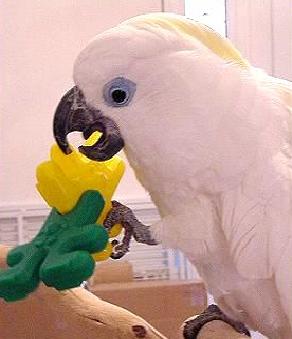Cockatoo - blue eyed
Scientific Name: Cacatua ophthalmica
Tue, 15th July, 2025 - 9:42 pm GMT
Sponsor Ads:

Alternative Name
Scientific Name: Cacatua ophthalmicaBasic Info
The Blue Eyed Cockatoo is a beautiful species of cockatoo. At maturity they will average between 45 and 50 centimeters in length and weigh between 500 and 570 grams. Their plumage is largely white, though a striking large yellow and white crest is seen atop their heads. The yellow feathers are behind the white and are often not seen until the crest is raised. Yellow can also be seen under the wings and tail feathers. They get their name from the striking blue rings around their eyes, a distinctive feature to be sure. The beak of the Blue Eyed Cockatoo is black. Males and females can often be distinguished by eye color. Males traditionally have a black iris, while the female's tends to be reddish.
Health
Blue Eyed Cockatoos may be fussy about food. Since they enjoy a wide variety of foods, it can be a constant test of trial and error to find the foods that each specific bird will eat. A good diet should consist of approx. 80% vegetables, pasta, fruits, meats, nuts, grains, etc. The remaining 20% should be a good commercial pellet diet or a healthy seed mixture. Avoid seeds high in sunflower and safflower, as these are very fatty and not terrible healthy. This species requires a daily shower. If a full shower cannot be given, they should at least be spray. This needs to be done to keep dust levels down, and feathers clean. This is reported to help prevent feather plucking which can be a problem in this species. Like other Cockatoos the Blue Eyed Cockatoo requires a significant amount of time and attention. Neglect will usually result in feather plucking and other forms of self-mutilation Breeding Breeding in captivity is virtually unknown. This species breeds in mating pairs, and usually mate May and October. A nest box measuring 40 x 40 x 100 cm is recommended. After mating, the female will lay to one or two eggs, which will hatch in about 28 days. Hatchlings usually fledge by their tenth month.Habitat
N/ABehavior
Truly an exotic bird, the Blue Eyed Cockatoo is a rare but beautiful parrot that is loved and admired by bird lovers throughout the world. Sadly the Blue Eyed Cockatoo is extremely rare both in the wild and in captivity. The Blue Eyed Cockatoo is reported to be one of the friendliest and most playful of all the cockatoos. The Blue Eyed Cockatoo does not mind being handled; in fact it seems to enjoy it, allowing itself to be picked up in most any position. In addition to their wonderful personalities, they are also supposed to be great mimics! The native habitat of the Blue Eyed Cockatoo is forested areas as high in elevation as 1,000 meters. The Blue Eyed Cockatoo is social and is usually seen in flocks of as few as two to as many as 10 to 20. The Blue Eyed Cockatoo is rather noisy, both in the wild and in captivity. This is a rather hardy bird that usually does well in captivity after it has had time to adjust. They enjoy chewing and should be provided many chew toys, so they do not become bored. These are highly intelligent birds that must have mental stimulation at all times in captivity. In addition, branches are a must, both for climbing and perching and for chewing. The average Blue Eyed Cockatoo lives 40 years in captivity. Surprisingly their lifespan in the wild is longer, 50 to 60 years. The decerased lifespan in captivity may be due to improper care.Origin
New BritainHistory
The Blue Eyed Cockatoo is native to the forests of New Britain, New Ireland, and the Bismarck Archipelago.Common Foods
N/ASponsor Ads:
"Bombay is 250ms from New York in the new world order" -- Alan Cox
Cockatoo - blue eyed
Coded by: BGID® | ALL RIGHTS RESERVED Copyright © 2000-2025
Disclaimer | Privacy | Report Errors / Contact | Credits








 President of the United States of America - Real Estate mogul, Pageant owner and now one of the most controversial men in political history.
President of the United States of America - Real Estate mogul, Pageant owner and now one of the most controversial men in political history.  Global warming has been in and out as the "latest" hot topic for many years. It is, according to modern scientists, the result of man-made industrial pollutants, clearing forested areas, agriculture, etc. But now they are thinking it started way before the Industrial Revolution...
Global warming has been in and out as the "latest" hot topic for many years. It is, according to modern scientists, the result of man-made industrial pollutants, clearing forested areas, agriculture, etc. But now they are thinking it started way before the Industrial Revolution...  Politician, US Vice President and President of the USA - Joseph Robinette Biden Jr.
Politician, US Vice President and President of the USA - Joseph Robinette Biden Jr.  versus
versus  Russia: 'The Evil Empire'? Are they all that bad or is it just the USA trying to portray Russia as bad because they are a world power with land bigger and a society very different from the USA ideal?
Russia: 'The Evil Empire'? Are they all that bad or is it just the USA trying to portray Russia as bad because they are a world power with land bigger and a society very different from the USA ideal? 
 Corona virus
Corona virus 
 Users with wide screen monitors can benefit from more content on every page.
Users with wide screen monitors can benefit from more content on every page.